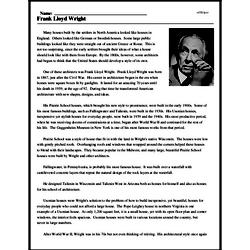Frank Lloyd Wright
Frank Lloyd Wright
Reading Comprehension for June 8
Many houses built by the settlers in North America looked like houses in England. Others looked like German or Swedish houses. Some large public buildings looked like they were straight out of ancient Greece or Rome. This is not too surprising, since the early settlers brought their ideas of what a house should look like with them from Europe. By the 1800s, however, some architects had begun to think that the United States should develop a style of its own.
One of these architects was Frank Lloyd Wright. Frank Lloyd Wright was born in 1867, just after the Civil War. His career in architecture began in the era when homes were square boxes lit by gaslights. It lasted for an amazing 70 years until his death in 1959, at the age of 92. During that time he transformed American architecture with new shapes, designs, and ideas.
His Prairie School houses, which brought his new style to prominence, were built in the early 1900s. Some of his most famous buildings, such as Fallingwater and Taliesin, were built in the 1930s. His Usonian houses, inexpensive yet stylish homes for everyday people, were built in 1939 and the 1940s. His most productive period, when he was receiving dozens of commissions at a time, began after World War II and continued for the rest of his life. The Guggenheim Museum in New York is one of his most famous works from that period.




